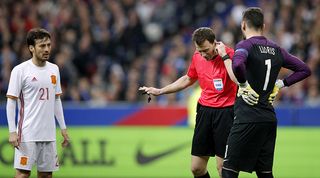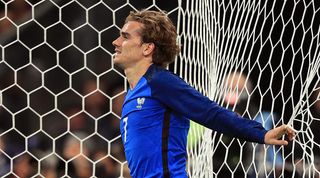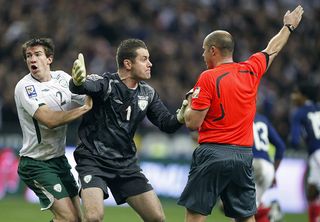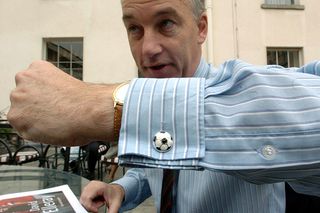What you need to know about video technology in football - and when we might see it in the Premier League
Less diving, more correct decisions is the aim - but will video technology help football? Amit Katwala answers the big questions

Football’s experimentation with video referees has been going on for a while, but last night’s friendly between France and Spain was the first time it has changed the outcome of a high-profile game – turning what could have been a 1-1 draw into a 2-0 win for Spain. First, French forward Antoine Griezmann had a headed goal disallowed for offside. Then in the second half, Spain’s Gerard Deulofeu had a disallowed goal reinstated after the video ref’s input.
The system has divided opinion. For some it’s long overdue, for others that it signals the death of football. But how does it actually work?
Last night’s friendly between France and Spain was the first time it has changed the outcome of a high-profile game – turning what could have been a 1-1 draw into a 2-0 win for Spain
What can be reviewed?
The lawmakers have tried to minimise the impact video assistant referees (VARs for short) will have on the flow of the game. That means there’s a very limited set of decisions that can be referred to them. The system can only be used for goals, penalty decisions, direct red cards and cases of mistaken identity. That’s why Deulofeu’s goal was eventually given, while an offside decision which didn’t result in a goal was not overruled.

Who can ask for a review?
It gets rid of the Thierry Henry goals, the Maradona goals – the sorts of situation which are clearly wrong
There is no appeals system of the like seen in cricket or tennis. Instead, match footage will be constantly reviewed by a VAR, who will alert the on-field official if they feel a potentially reviewable error has been made. Only the referee can initiate a review – either on the VAR's recommendation, or if he feels a mistake has been made.
The referee’s original decision will stand unless it is clearly wrong. Former referee David Elleray is part of the panel that devised the rules surrounding the use of video technology. He said at a presentation that the intent is not to make every decision 100 per cent accurate, but instead to reduce some of the giant, game-changing gaffes that occasionally arise. "It gets rid of the Thierry Henry goals, the Maradona goals – the sorts of situation which are clearly wrong," claims Elleray.
Get FourFourTwo Newsletter
The best features, fun and footballing quizzes, straight to your inbox every week.
What can the video ref see?
The VAR will be either in a room at the stadium, in a van parked outside alongside the television trucks, or – for league games – in a central location somewhere in the country. During the trial period, the VAR must be a current or former top-flight official. He will have his own assistant, who will keep an eye on the game while the VAR reviews specific decisions and flags up potential incidents.
There will also be a replay operator to cue up footage that the VAR wants to look at. He will have independent access and replay control of all the match footage – he must be able to see anything that the television companies could show. The International Football Association Board (IFAB) are recommending that slow motion should not be used for decisions about the severity of a tackle, as it tends to exaggerate things.

Who makes the decision?
The referee will signal a review by making a television signal. There are two different types of review, which will be used in different scenarios. For factual decisions, such as whether a foul was inside or outside the penalty area – or tight offside calls – the VAR will usually make the calls themselves. For other, more subjective decisions such as red cards, the referee – who has more of a feel for the game – can choose to conduct an ‘on-field review’, where he’ll go over to a screen at the side of the pitch and view the footage himself.
How far back can a review go?
The referee can only go back to the start of the attacking phase which leads up to the incident. So if a throw-in decision goes the wrong way, resulting in a goal, the referee can’t go back and review the throw-in decision. But if the attacking team wins the ball illegally, then the goal can be disallowed. A review can only happen before play has restarted, so savvy players who think they’ve got away with a foul in the area or a red card tackle could attempt to prevent a review by continuing with play as quickly as possible.
What if the ball is still in play?
Of course, not all contentious decisions end with the ball going out of play. In that case, the referee will wait until the ball is in a neutral zone before stopping play – just like they’re supposed to at half-time or full-time. If the decision is not overturned, play will restart with a drop ball. The contested drop ball could become a much more common sight – one to cross off your football bingo card.

What happens if there’s a goal at the other end?
This does raise the spectre of what Elleray called the “nightmare scenario” where, for example, a Spain player is fouled in the box at one end but the on-pitch referee doesn’t spot it – then France immediately take the ball up the other end and score before the referee can stop play. In that case, France’s goal would be disallowed and Spain would get a penalty.
When will it reach the Premier League?
The technology is still in the trial phase. It’s a two year experiment being run by IFAB, the organisation which determines the Laws of the Game. A final decision will be taken on whether to approve the technology at the IFAB Annual General Meeting in March 2018. That means the earliest we could see video assistant referees (VARs) in use in the Premier League will be the start of the 2018/19 season. However, they will be used in the FA Cup next season from the third round, as part of the trial.
Will it work?
Like any change in football, video technology has already polarised opinion. The system that’s been designed appears to strike a good balance between maintaining the flow of the game and correcting some grave injustices. It’s thought that the VAR will only be needed once or twice per game on average – the system might need tweaking if it ends up being more often than that.
It only took 40 seconds for Deulofeu’s goal to be correctly ruled onside – not much longer than players might have spent arguing with the linesman anyway. There will be unseen challenges ahead. Incidents such as the Zlatan Ibrahimovic/Tyrone Mings scrap will take a lot longer to unpick – and the first time a goal at one end gets disallowed to give a penalty at the other, there will be uproar.

It will also be interesting to see whether this changes behaviour on the pitch. Elleray thinks it will make it much harder for players to dive for penalties and for them to get away with violent conduct. It might also, however, change the way officials behave. Will they give more leeway to decisions because they know they’ve got the VAR backing them up?
It would be all too easy to allow attackers the benefit of the doubt on tight offside calls because the video replay will show you if they were offside or not immediately afterward. That might not necessarily be a bad thing.
One thing that last night’s overturned decisions demonstrated clearly is that football has not yet done a good job of explaining the system to fans. One innovation from rugby might help that: broadcasting the conversations between the on-pitch referee and the VAR would help create transparency for the decisions, and explain what’s going on to fans.
We’ve been through this technological debate once already with goal-line technology, which was eventually introduced after years of debate. That now seems as natural as the offside rule. VARs come with a lot more complications, but the hope is that they follow a similar trajectory.

Thank you for reading 5 articles this month* Join now for unlimited access
Enjoy your first month for just £1 / $1 / €1
*Read 5 free articles per month without a subscription

Join now for unlimited access
Try first month for just £1 / $1 / €1

